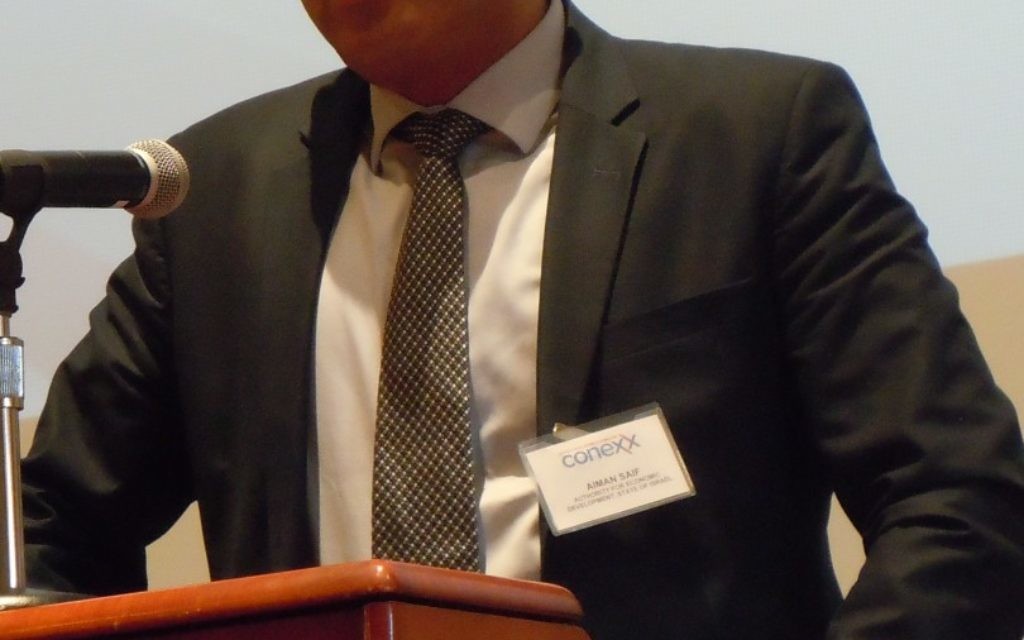Israel Investing in Arab Economy
Two population sectors are holding back the Israeli economy by not fully participating: the Haredi, who have religious reasons, and the Arabs.
As a result, the startup nation is lagging in many statistics compared with other members of the Organization of Economic Cooperation and Development, said Guy Tessler, the president of Conexx: America Israel Business Connector. How the government is addressing the problem with the Arab population, which is 21 percent of Israel but creates only 8 percent of the gross domestic product, was the subject of a Conexx seminar Thursday, Feb. 11, at The Temple.
“We are doing a lot to change this situation,” said Aiman Saif, the director general of the Authority for Economic Development of the Minorities Sector. “Israel cannot be a world GDP leader without the Arab sector.”
Get The AJT Newsletter by email and never miss our top stories Free Sign Up
In 2007, when Ehud Olmert was prime minister, the government began investing in Arab economic development. It’s a commitment that has remained as governments have changed and has produced a five-year comprehensive plan costing about $2.5 billion through 2020.
The heart of the issue is the low workforce participation rate among Arabs, particularly women, Saif said. As of 2014, only 30 percent of Arab women were in the labor market, compared with 70 percent of Arab men. That rate for women is low even compared with surrounding Middle East nations, he said.
As a result, Israel’s overall labor participation rate was 74 percent, compared with an OECD average of 84 percent to 85 percent.
The issue is not cultural, Saif said; it’s simply a lack of jobs, although a dearth of day care centers and public transit in Arab areas and lower educational attainment are contributing factors.
Israel is making progress, however. Only 18 percent of Arab women were in the labor market in 1990, and the rate was only 20 percent in 2000. The goal is 42 percent by 2020.
Saif listed the top obstacles and opportunities for Arab economic development.
The obstacles:
- Over 70 percent of Israeli Arabs live in the nation’s periphery, away from the jobs and services in the center of the country.
- Over 70 percent live in Arab communities, which typically have fewer services than Jewish communities.
- The economic infrastructure is bad.
- The local government authorities are poor.
- The educational level is low.
- Networking and Internet access are limited.
- There’s prejudice in the job market.
The opportunities:
- Positive trends in education.
- Positive trends in employment.
- Untapped local assets, such as tourist sites.
- Untapped human potential.
- The willingness of Arab women to integrate into the workforce.
- The government recognition of Arab needs.
Arabs are achieving in some areas, such as medicine, where more than half the doctors and nurses in hospitals are Arabs, Saif said. But 4,000 licensed Arab pharmacists are unemployed, and only 2 percent of high-tech engineers are Arabs in a nation facing a labor shortage of more than 4,000 engineers.
Israelis often cite their army service as the source of the training and connections for high-tech innovation, but Saif said that’s not the obstacle to Arab high-tech success because the statistics are the same for Druze, who join the Israel Defense Forces, and Muslims, who do not.
The government is creating tools to spark high-tech employment among Arabs, including incubators that invest up to $600,000 in each startup business and a college scholarship fund.
Israel has made 14,000 job placements through new employment centers and is investing tens of millions of dollars to open more. Israel also is making microloans to develop women’s businesses and is investing in Arab infrastructure, including extensive bus lines.
“There are still a lot of challenges. The gaps are big,” Saif said. “But I think we’re moving in the right direction.”






comments